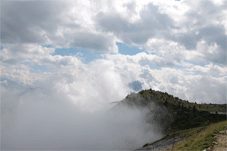Clouds
Clouds... what are they actually?
Everyone knows the clouds in the sky and that they consist of water and can bring rain. But how do clouds develop and how do they affect the weather?
Origin of clouds

When water evaporates, water vapour enters the atmosphere. The air can only take up a certain
amount of water. As soon as the dew point (maximum water absorption capacity of air) is reached, the relative
humidity reaches 100%. Important: the warmer the air, the higher the dew point (the more water vapour can be taken
up by the air). The dew point is usually expressed as temperature (°C).
If the air temperature falls below the
dew point, the water vapour begins to condensate. A concrete example: after a long warm shower in the bathroom, the
windows and mirror often become "wet". The air cannot take up all the water vapour, which then settles in such a way
on colder surfaces. The formation of clouds is not at all different. In the air, many so-called small "condensation
nuclei" (or "cloud seeds") float around. Those are tiny small particles that we can not see, e.g. dust, soot, and
also salt particles when close to the sea.
The water droplets start settling on these cloud seeds. The resulting droplets are on average 0.001 millimeters large. If many of these droplets accumulate, clouds develop.
How does a cloud then develop? Warm air rises by heating up in the sunlight and cools down
after rising for some kilometres again. The dew point is lowered by the cooling of air. Since the quantity of the
water vapour in the air remains the same, the condensation point is reached at some stage and vapour begins to
condensate. A cloud develops.
As well, clouds may develop with warm and cold fronts, where larger temperature differences
occur.
Effect on the weather
Clouds have an enormous effect on the weather. For example, if a thick cloud layer draws up in the summer, the air becomes noticeably colder because the sunbeams cannot pass through the clouds and the air is not heated anymore. At night, the reverse happens. In a clear night, it is colder because the heat radiates away into space. If the sky is covered at night, then the majority of the heat between ground and cloud remains below the clouds.
Clouds are also important for the water regime of the Earth, since they are the fastest route of transportation for water.
Cloud types
Their forms and interpretations are described on cloud types.


